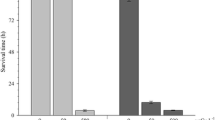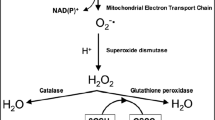Abstract
Acutely lethal (24 h) exposure of adult rainbow trout (Oncorhynchus mykiss) to 4.9 μmol copper·l-1 in fresh water (pH 7.9, [Ca2+]≈0.8 mEq·l-1) caused a rapid decline of plasma Na+ and Cl- and arterial O2 tension, and initially a pronounced tachycardia. The internal hypoxia probably resulted from histopathologies observed in the gills of fish exposed to copper, such as cell swelling, thickening and curling of the lamellae, and haematomas. Copper cannot therefore be considered purely as an ionoregulatory toxicant during acutely lethal conditions. Mortality during exposure to copper could not simply be explained by the plasma ionic dilution, nor by the internal hypoxia, since arterial O2 content remained relatively unchanged. Secondary to the ionoregulatory and respiratory disturbances were a number of deleterious physiological responses which included a massive haemoconcentration (haematocrit values as high as 60%) and a doubling of the mean arterial blood pressure. The time-course of these changes suggest that cardiac failure was the final cause of death. In this respect copper exposure resembles low pH exposure in freshwater trout (Milligan and Wood 1982). Copper and H+ appear to be similar in both the primary site of their toxic action (the gills) and the secondary physiological consequences which result from acutely lethal exposures. Furthermore, the acute toxicity syndrome observed may be common to many metals which cause ionoregulatory and/or respiratory problems in freshwater fish.
Similar content being viewed by others
Abbreviations
- C aO2 :
-
arterial oxygen content
- FR:
-
water flow rate
- Hb:
-
haemoglobin
- Hct:
-
haematocrit
- ΔH +m :
-
net metabolic acid load
- IU:
-
international unit
- MABP:
-
mean arterial blood pressure
- MCHC:
-
mean corpuscular haemoglobin content
- MO2 :
-
rate of oxygen consumption
- P aCO2 :
-
arterial carbon dioxide tension
- P aO2 :
-
arterial oxygen partial pressure
- T amm :
-
total ammonia (=NH3+NH +4 )
- TCO2 :
-
total carbon dioxide
- TOC:
-
total organic carbon
- %Hb−O2 :
-
percentage of haemoglobin saturated with oxygen
References
Alabaster JS, Lloyd R (1980) Copper. Water quality criteria for freshwater fish. Butterworths, London, pp 189–220
Boutilier RG, Heming TA, Iwama GK (1984) Physicochemical parameters for use in fish respiratory physiology. In: Hoar WS, Randall DJ (eds) Fish physiology, vol XA. Academic Press, London, pp 403–430
Boutilier RG, Iwama GK, Randall DJ (1986) The promotion of catecholamine release in rainbow trout, Salmo gairdneri, by acute acidosis: interactions between red cell pH and haemoglobin oxygen carrying capacity. J Exp Biol 123:145–157
Burton AC (1972) Physiology and biophysics of the circulation, 2nd edn. Yearbook Medical Publishers, Chicago
Cameron JN (1971) Rapid method for the determination of total carbon dioxide in small blood samples. J Appl Physiol 31:632–634
Campbell PGC, Stokes PM (1985) Acidification and toxicity of metals to aquatic biota. Can J Fish Aquat Sci 42:2034–2049
Christensen GM, McKim JM, Brungs WA, Hunt EP (1972) Changes in the blood of the brown bullhead (Ictalurus nebulosus Lesueur) following short and long term exposure to copper (II). Toxicol Appl Pharmacol 23:417–427
Flemming CA, Trevors JT (1989) Copper toxicity and chemistry in the environment: a review. Water Air Soil Pollut 44:143–158
Holeton EF, Randall DJ (1967) Changes in blood pressure in the rainbown trout during hypoxia. J Exp Biol 46:297–305
Howarth RS, Sprague JB (1978) Copper lethality to rainbow trout in waters of various hardness and pH. Water Res 12:455–462
Hughes GM, Perry SF (1976) A morphometric study of trout gills: a light-microscopic method for the evaluation of pollutant action. J Exp Biol 64:447–460
Jobling M (1981) The influence of feeding on the metabolic rate of fishes: a short review. J Fish Biol 18:385–400
Kijeniuk JW, Jones DR (1977) The oxygen transport system in trout (Salmo gairdneri) during sustained exercise. J Exp Biol 69:247–280
Ladé RI, Brown EB Jr (1963) Movement of potassium between muscle and blood in response to respiratory acidosis. Am J Physiol 204:761–764
Laurén DJ, McDonald DG (1985) Effects of copper on branchial ionoregulation in the rainbow trout, Salmo gairdneri Richardson. Modulation by water hardness and pH. J Comp Physiol B 155:635–644
Laurén DJ, McDonald DG (1986) Influence of water hardness, pH, and alkalinity on the mechanisms of copper toxicity in juvenile rainbow trout, Salmo gairdneri. Can J Fish Aquat Sci 43:1488–1496
Laurén DJ, McDonald DG (1987) Acclimation to copper by rainbow trout, Salmo gairdneri: physiology. Can J Fish Aquat Sci 44:99–104
Lee RM, Shelby DG, Jezierska B (1983) Electrolyte balance and energy mobilization in acid-stressed rainbow trout, Salmo gairdneri, and their relation to reproductive success. Environ Biol Fish 8:115–123
Lewis SD, Lewis EM (1971) The effect of zinc and copper on the osmolality of blood serum of the channel catfish Ictalurus punctatus Rafinesque, and the golden shiner Notemigonus chrysoleucas Mitchell. Trans Am Fish Soc 100:639–643
McDonald DG (1983) The effects of H+ upon the gills of freshwater fish. Can J Zool 61:691–703
McDonald DG, Hobe H, Wood CM (1980) The influence of calcium on the physiological responses of the rainbow trout, Salmo gairdneri, to low environmental pH. J Exp Biol 88:109–131
McDonald DG, Walker RL, Wilkes PRH (1983) The interaction of environmental calcium and low pH on the physiology of the rainbow trout, Salmo gairdneri. II. Branchial ionoregulatory mechanisms. J Exp Biol 102:141–155
McDonald DG, Reader JP, Dalziel TRK (1989) The combined effects of pH and trace metals on fish ionoregulation. In: Morris R, Taylor EW, Brown JA (eds) Acid toxicity and aquatic animals. Soc Exp Biol Semin Ser, vol 31. Cambridge University Press, pp 221–242
McKim JM, Christensen GM, Hunt EP (1970) Changes in the blood of the brook trout, Salvelinus fontinalis, after short-term and long-term exposure to copper. J Fish Res Bd Can 27:1883–1889
Mallatt J (1985) Fish gill structural changes induced by toxicants and other irritants: a statistical review. Can J Fish Aquat Sci 42:630–648
Miles HM (1971) Renal functioning in migratory adult coho salmon. Comp Biochem Physiol 38A:797–826
Milligan CL, Wood CM (1982) Disturbances in haematology, fluid volume, distribution and circulatory function associated with low environmental pH in the rainbow trout, Salmo gairdneri. J Exp Biol 99:397–415
Nikinmaa M (1986) Control of red cell pH in teleost fishes. Ann Zool Fennici 23:223–235
Nilsson S, Grove DJ (1974) Adrenergic and cholinergic innervation of the spleen of the cod: Gadus morhua. Eur J Pharmacol 28:135–143
Packer RK (1979) Acid-base balance and gas exchange in brook trout (Salvelinus fontinalis) exposed to acid environments. J Exp Biol 79:127–134
Parfitt AM, Kleerekoper M (1980) In: Maxwell M, Kleeman C (eds) Clinical disorders of fluid and electrolyte metabolism. McGraw-Hill, San Francisco, pp 947–1151
Perry SF, Davie PS, Daxboeck C, Ellis AG, Smith DG (1984) Perfusion methods for the study of gill physiology. In: Hoar WS, Randall DJ (eds) Fish physiology, vol XB. Academic Press, London, pp 326–381
Reader JP, Everall NC, Sayer MDJ, Morris R (1989) The effects of eight trace metals in acid soft water on survival, mineral uptake and skeletal calcium deposition in yolk-sac fry of brown trout, Salmo trutta L. J Fish Biol 35:187–198
Reid SD, McDonald DG (1988) Effects of cadmium, copper, and low pH on ion fluxes in the rainbow trout, Salmo gairdneri. Can J Fish Aquat Sci 45:244–253
Ruben JA, Bennett AF (1981) Intense exercise, bone structure and blood calcium levels in vertebrates. Nature (London) 291:411–413
Satchell GH (1984) Respiratory toxicology of fishes. In: Weber LJ (ed) Aquatic toxicology. Raven Press, New York
Sayer MD, Reader PJ, Dalziel TRK, Morris R (1991a) Mineral content and blood parameters of dying brown trout (Salmo trutta L.) exposed to acid and aluminium in soft water. Comp Biochem Physiol 99C:345–348
Sayer MD, Reader JP, Morris R (1991b) Effects of six trace metals on calcium fluxes in brown trout (Salmo trutta L.) in soft water. J Comp Physiol B 161:537–542
Schreck CB, Lorz HW (1978) Stress resistance of coho salmon (Oncorhynchus kisutch) elicited by cadmium and copper, and potential use of cortisol as an indicator of stress. J Fish Res Bd Can 35:1124–1129
Soivio A, Westman K, Nyholm K (1972) Improved method of dorsal aorta catheterization: haematological effects followed for three weeks in rainbow trout (Salmo gairdneri). Finn Fish Res 1:11–21
Spear PA, Pierce RC (1979) Copper in the aquatic environment: chemistry, distribution and toxicology. National Research Council of Canada, Environmental Secretariate Publication No 16454. Publications NRCC, Ottowa, pp 62–190
Sprague JB (1971) Measurement of pollutant toxicity to fish. III Sublethal effects and “safe” concentrations. Water Res 5:401–408
Stagg RM, Shuttleworth TJ (1982) The accumulation of copper in Platichthys flesus L. and its effects on plasma electrolyte concentrations. J Fish Biol 20:491–500
Stuart S, Morris R (1985) The effects of season and exposure to reduced pH (abrupt and gradual) on some physiological parameters in brown trout (Salmo trutta). Can J Zool 63:1078–1083
Taylor EW, Wheatly MG (1981) The effect of long-term aerial exposure on heart rate, ventilation, respiratory gas exchange and acid-base status in the crayfish Austropotamobius pallipes. J Exp Biol 92:109–124
Taylor EW, Tyler-Jones R, Wheatly MG (1987) The effects of aerial exposure on the distribution of body water and ions in the freshwater crayfish Austropotamobius pallipes (Lereboullet). J Exp Biol 128:307–322
Tetens V, Christensen NJ (1987) Beta-adrenergic control of blood oxygen affinity in acutely hypoxia exposed rainbow trout. J Comp Physiol 157 B:667–675
Tetens V, Lykkeboe G (1981) Blood respiratory properties of rainbow trout: responses to hypoxia acclimation and anoxic incubation of blood in vitro. J Comp Physiol 145:117–125
Tucker VA (1967) Method for oxygen content and dissociation curves on microliter blood samples. J Appl Physiol 23:410–414
Ultsch GR, Gros G (1979) Mucus as a diffusion barrier to oxygen: possible role in O2 uptake at low pH in carp (Cyprinus carpio) gills. Comp Biochem Physiol 62A:685–689
Wilson RW, Taylor EW (1993) Differential physiological responses to copper in rainbow trout (Oncorhynchus mykiss) acclimated to seawater and brackish water. J Comp Physiol B (in press)
Witters HE, Van Puymbroek S, Van Den Sande I, Vanderborght OLJ (1990) Haematological disturbances and osmotic shifts in rainbow trout, Oncorhynchus mykiss (Walbaum) under acid and aluminium exposure. J Comp Physiol 160 B:563–571
Witters HE, Van Puymbroek S, Vanderborght OLJ (1991) Adrenergic response to physiological disturbances in rainbow trout, Oncorhynchus mykiss, exposed to aluminium at acid pH. Can J Fish Aquat Sci 48:414–420
Wood CM (1974) Pharmacological properties of the adrenergic receptors regulating systemic vascular resistance in the rainbow trout. J Comp Physiol 107:211–228
Wood CM (1989) The physiological problems of fish in acid waters. In: Morris R, Taylor EW, Brown AJ (eds) Acid toxicity and aquatic animals. Soc Exp Biol Semin Ser, vol 31. Cambridge University Press, pp 125–152
Wood CM, McDonald DG (1982) Physiological mechanisms of acid toxicity to fish. In: Acid rain/fisheries. Proceedings of an international symposium on acidic precipitation and fishery impacts in north-eastern North America. American Fisheries Society. Bethesda, Maryland, pp 197–226
Wood CM, McDonald DG, McMahon BR (1982) The influence of experimental anaemia on blood acid-base regulation in vivo and in vitro in the starry founder (Platichthys flesus) and the rainbow trout (Salmo gairdneri). J Exp Biol 96:221–237
Wright PA, Wood CM (1985) An analysis of branchial ammonia excretion in the freshwater rainbow trout: effects of environmental pH change and sodium uptake blockade. J Exp Biol 114:329–353
Author information
Authors and Affiliations
Rights and permissions
About this article
Cite this article
Wilson, R.W., Taylor, E.W. The physiological responses of freshwater rainbow trout, Oncorhynchus mykiss, during acutely lethal copper exposure. J Comp Physiol B 163, 38–47 (1993). https://doi.org/10.1007/BF00309663
Accepted:
Issue Date:
DOI: https://doi.org/10.1007/BF00309663




